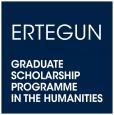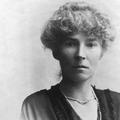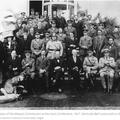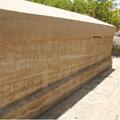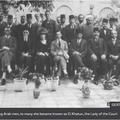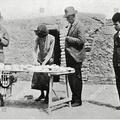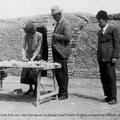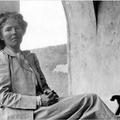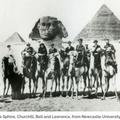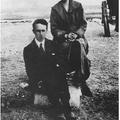Owning the Past: Gertrude Bell and the Making of the Middle East
BELLS OF CHANGE
On Wednesday, January 27th 2021, we were invited to listen to an exciting and exclusive online talk hosted by the Ashmolean Museum. The event was a part of the exhibition in Gallery 8 of the Ashmolean Museum: Owning the Past: From Mesopotamia to Iraq, which was open to visitors last summer. Paul Collins, Curator of the Ancient Near Eastern Collections, also the curator of the temporary exhibition and one of the editors of the book Gertrude Bell and Iraq: A life and legacy (2017), gave the talk. Listening to online talks has become a part of our lives in the past year, but the virtual world is never without its fun and games. There were some unfortunate technical issues at the beginning of the talk, which were quickly and professionally sorted out. Paul Collins specialises on the legacy of Gertrude Bell and on the effects of war and destruction on the ancient culture of the Middle East.
The exhibition had a critical approach to the ‘colonisation’ of both the heritage and the identities of Mesopotamia during the First World War and in the many decades that followed it. It was the first bilingual (English and Arabic) exhibition at the Ashmolean. It gave the opportunity to see the issues of archaeology, collections, and colonialism from the eyes of the inhabitants of the region. It questions the excavations led by the University of Oxford and the artefacts brought to the Ashmolean Museum between 1923 and 1933 and what implications the British interventions have had on the present situation of Iraq. Likewise, the talk on Gertrude Bell, a much-admired woman for her strength, ambitions, and affection, had a critical tone, seeing her as a part of the more general issues caused by the presence of Britain in the Middle East at the turn of the century.
Gertrude Margaret Lowthian Bell was born in 1868 in Durham to Hugh and Mary Bell. Gertrude lost her mother when she was only three years old, which may have been the main reason of her strong independence and determination, and the special bond she had with her father, an industrialist, and second baronet. The wealth of her father gave Gertrude the opportunity to excel in both her intellectual and her athletic tendencies. Before she was 18, she was accepted to Lady Margaret Hall at Oxford University to study Modern History – one of the few subjects that women were allowed to study at the time. She graduated with a first class honours degree – the first woman to do so – in only two years, but was not awarded an academic degree due to her gender.
Besides her passion and excellence in mountaineering (she climbed the Alps several times until 1904, recording first ascents and registering ten new routes), Bell was passionate about the Middle East, a feeling probably brought on by her several visits to the region. Bell visited Constantinople in 1889 followed by a visit to her uncle, Frank Lascelles, who was British minister in Tehran in 1892. By then she had conquered the Persian language to the point of translating the poems of Hafiz. She was invited to Jerusalem by German Consul Friedrich Rosen in 1900, during which she got the opportunity to see Petra, Palmyra, and Baalbek, giving her the opportunity to practice her Arabic and to take a peek into Syrian archaeology. Then, in 1905 she returned to Jerusalem only to embark on a journey through the Syrian dessert into Konya in Central Anatolia where she met archaeologist William Ramsay together with whom she carried out several studies in the region followed by academic publications. After this, she spent most of her time doing archaeological work in Anatolia and Mesopotamia, publishing both on her academic work and on her personal observations of the region, culture, politics and people.
At the times when she returned to England, she would spend time with her father in the family home. In contrast to all these successful moves as a single woman, she was against enfranchising women in parliamentary elections and worked for the anti-suffrage cause.
Bell was elected a fellow of the Royal Geographical Society in June 1913 and in December 1913 she set out from Damascus with her camel caravan to Ha’il in central Arabia, a journey that took three months in the company of Arabian drivers and guides, returning back to Damascus in May 1914. During these visits Bell was not only intrigued by the history, archaeology and architecture, but also by the inhabitants and the culture of the region. She got to know the Arabs, Armenians, Kurds, Persians, and Turks to name a few of the populations living in the region. She was able to gather substantial information on the Ottoman politics, on the Young Turk movement (1908), the Bedouin tribes, the Rashids, the Shiites, and the Sunnites.
Bell was in service from home during the first months of the First World War, but, in November 1915, she found herself in Cairo on the invitation of archaeologist David George Hogarth, to assist the military intelligence department, later known as the Arab Bureau, which carried the aim of ousting the Ottoman Empire from the region and establishing British power instead. This is where she started working with T.E. Lawrence (popularly known as Lawrence of Arabia), whom she had met before in Carchemish. Bell’s mission was to gather information on the Bedouin tribes. In June 1916 she was appointed assistant political officer. A year after Britain’s capture of Baghdad from the Ottoman Empire, in March 1917, Bell started to speak up about her own ideas, and even conspire at times as the Oriental Secretary to the High Commissioner for Iraq. There were important decisions to be made for Iraq’s future. She supported the idea of Arab governments with British advisers rather than a British rule in the area (although she believed in the opposite until the Paris peace conference in 1919).
In April 1920 Britain established mandate over Iraq but tribal uprisings began shortly after. In March 1921 Churchill agreed to the Arab regime with British guidance. At this point, Bell and Lawrence instigated bringing Feisal ibn Hussein to the throne in August 1921. Bell also took part in the treaty of 1922, which ended the British mandate in Iraq. Bell’s interventions finally helped sign the protocol in 1923 establishing Iraq’s borders with the new countries of Jordan, Saudi Arabia and Turkey.
After Iraq established its new constitution in 1924, Bell concentrated on her archaeological work again, eventually leading to the foundation of the national museum in 1926 and, later, that of the British School of Archaeology in Iraq (founded in 1932, its first director was Max Mallowan, Agatha Christie’s husband). Bell strongly supported the heritage to remain in the country of origin but donated to the Ashmolean seals and other objects she had collected in Syria. Bell died in Baghdad shortly after the inauguration of the museum in June 1926 due to the intake of an excessive amount of sleeping pills. She was buried in the British cemetery in Baghdad.
Gertrude Bell’s intricate accounts and photographs of the Middle East are truly fascinating. She was a talented and truly admirable woman who had no boundaries. Her personal letters and diaries, on the other hand, give us an insight to her emotional state, her personal relationships, her personal observations and the current situation in the countries she visited, however biased they may be.
The talk, as a whole, was very inspiring inasmuch as we are now able to openly talk about past mistakes in politics and that there is change in how we approach culture and heritage – finally choosing the path of equity by giving voice to those who were most affected by political and cultural decisions and approaches rather than focusing on what we gained from it.
Serra Somersan
Photo sources:
Bell 1: https://www.biography.com/news/gertrude-bell-biography-facts
Bell 2: https://worldofwonder.net/bornthisday-traveler-gertrude-bell/
Bell 3: https://eleanorscottarchaeology.com/els-archaeology-blog/2017/3/17/the-death-of-gertrude-bell
Bell 4: https://www.thoughtco.com/gertrude-bell-4691614
Bell 5: https://hadeelalsayegh.files.wordpress.com/2013/08/bell-pic.jpg
Bell 6: https://www.bbc.com/news/uk-england-tyne-25775990#next
Bell 7b: http://gertrudebell.ncl.ac.uk/personalia.php?photo_id=100
Bell 8: http://www.milliyetsanat.com/haberler/elestiri/colun-kizi-gertrude-bell/10104

